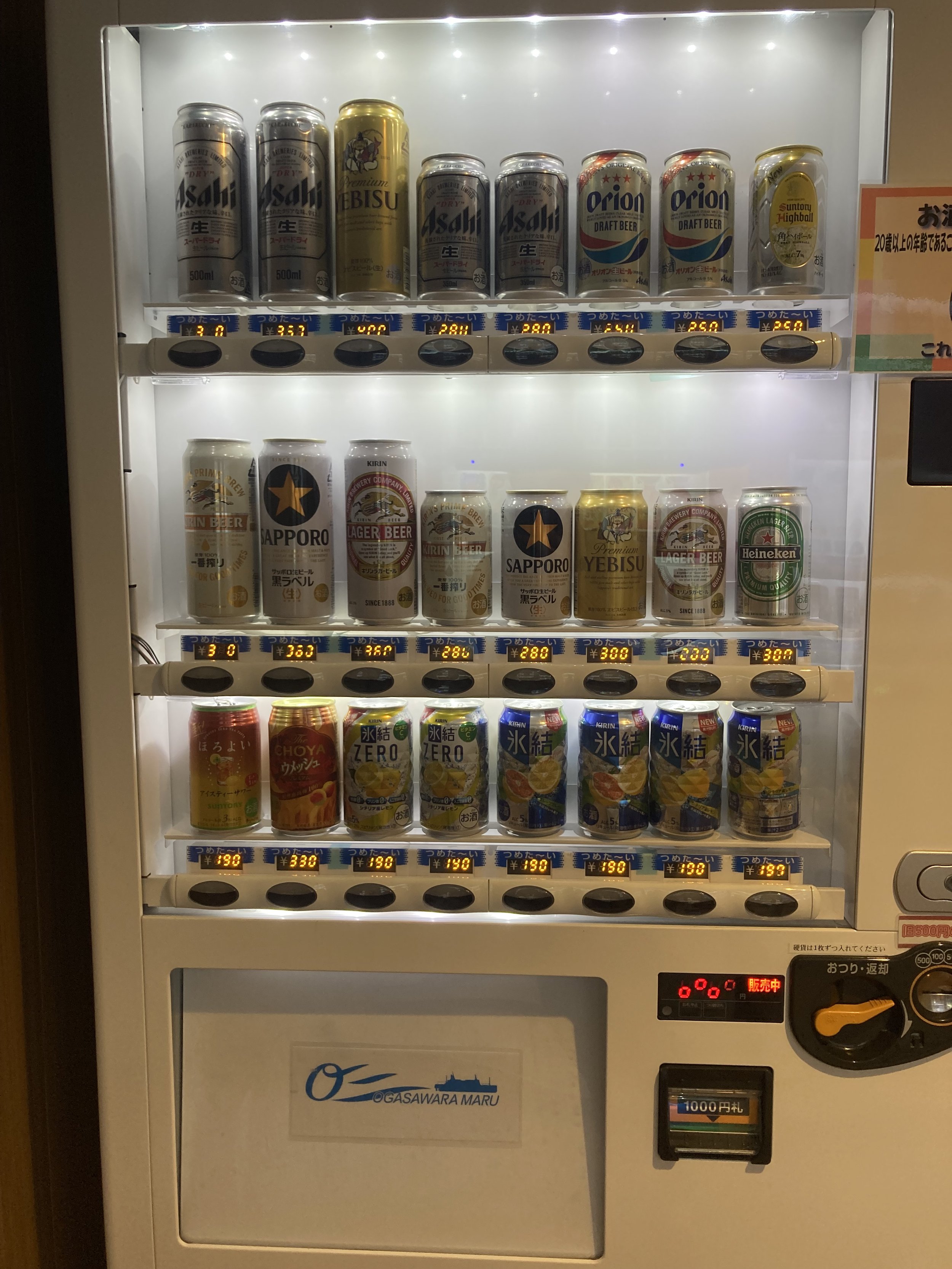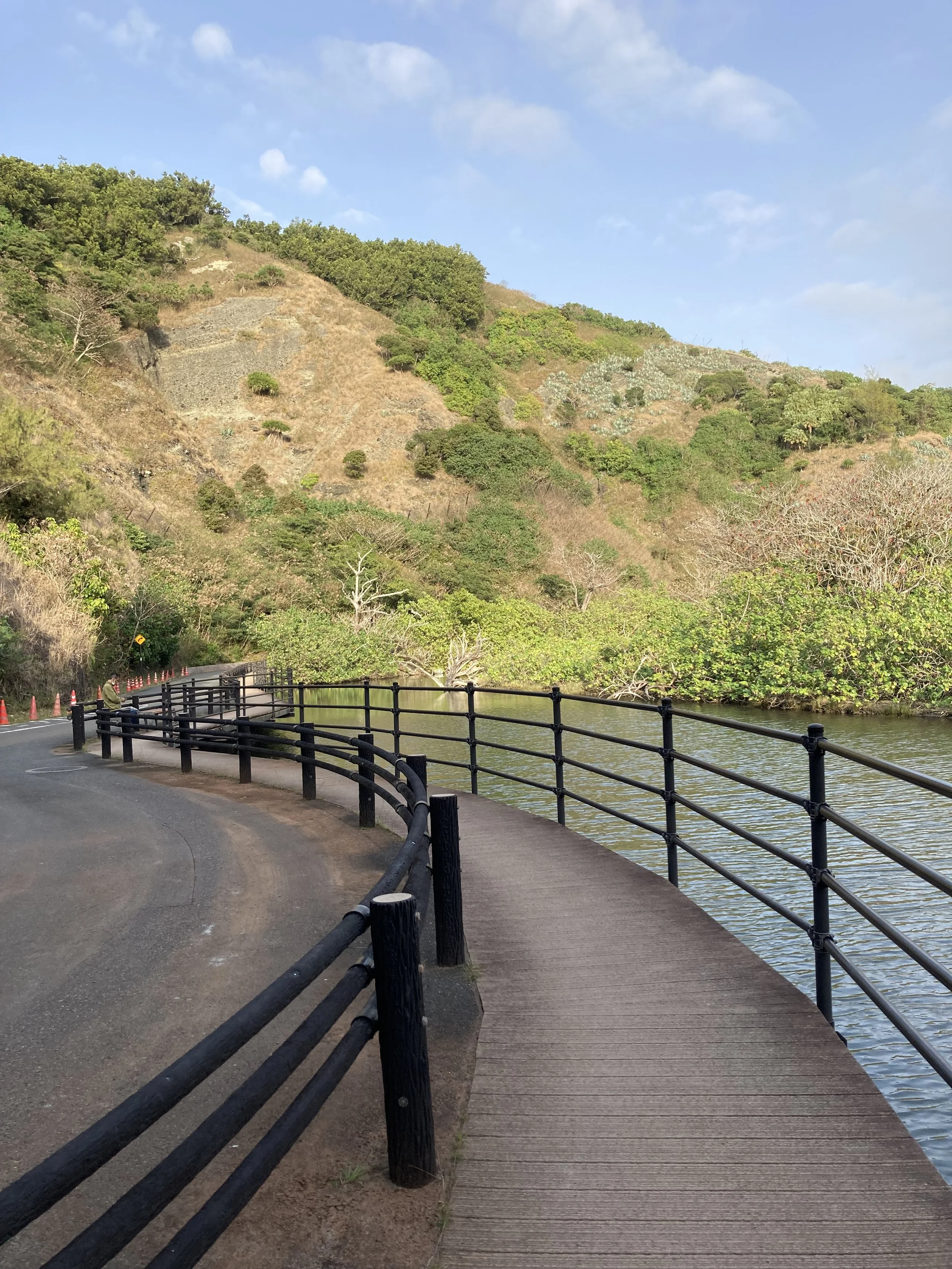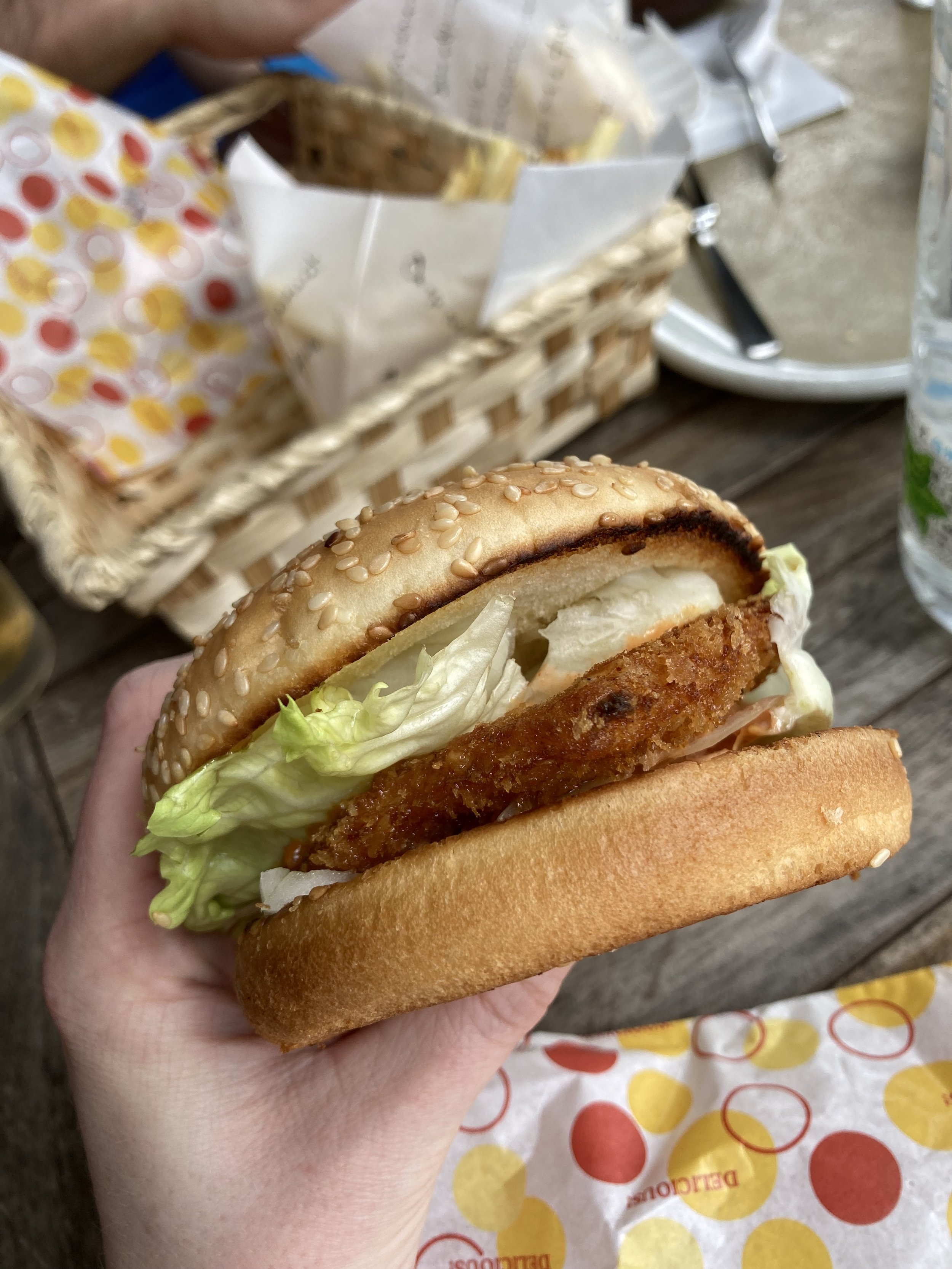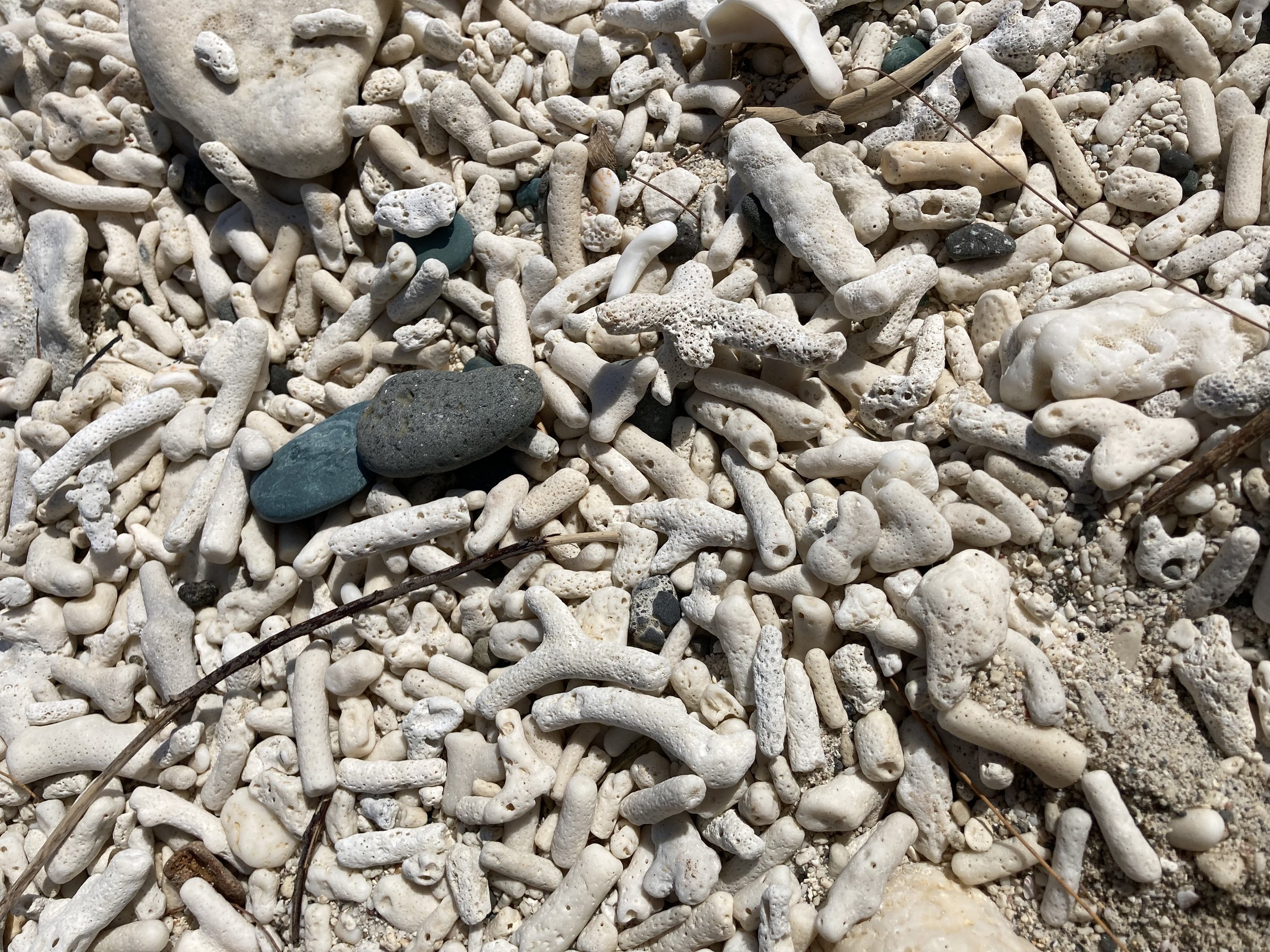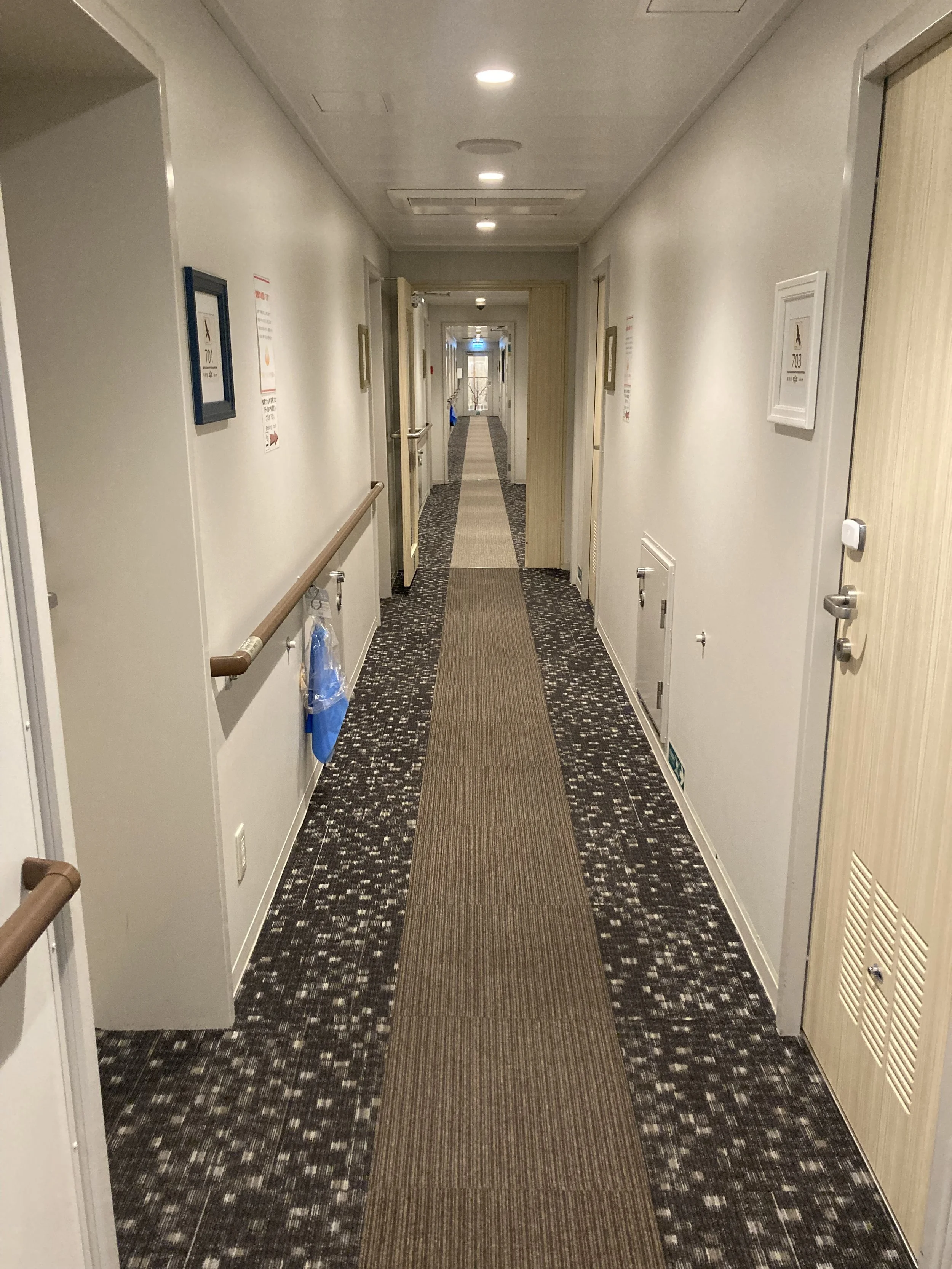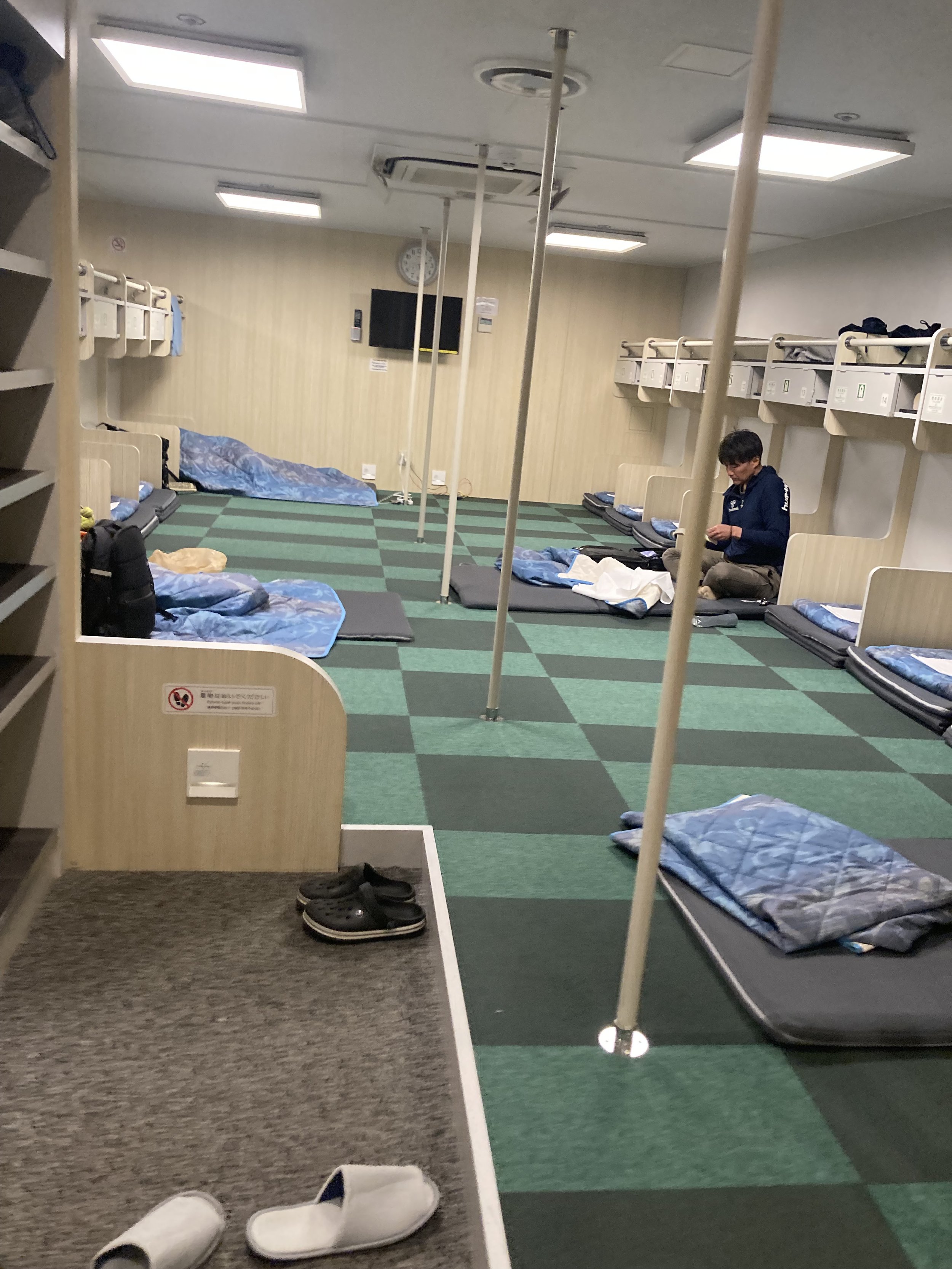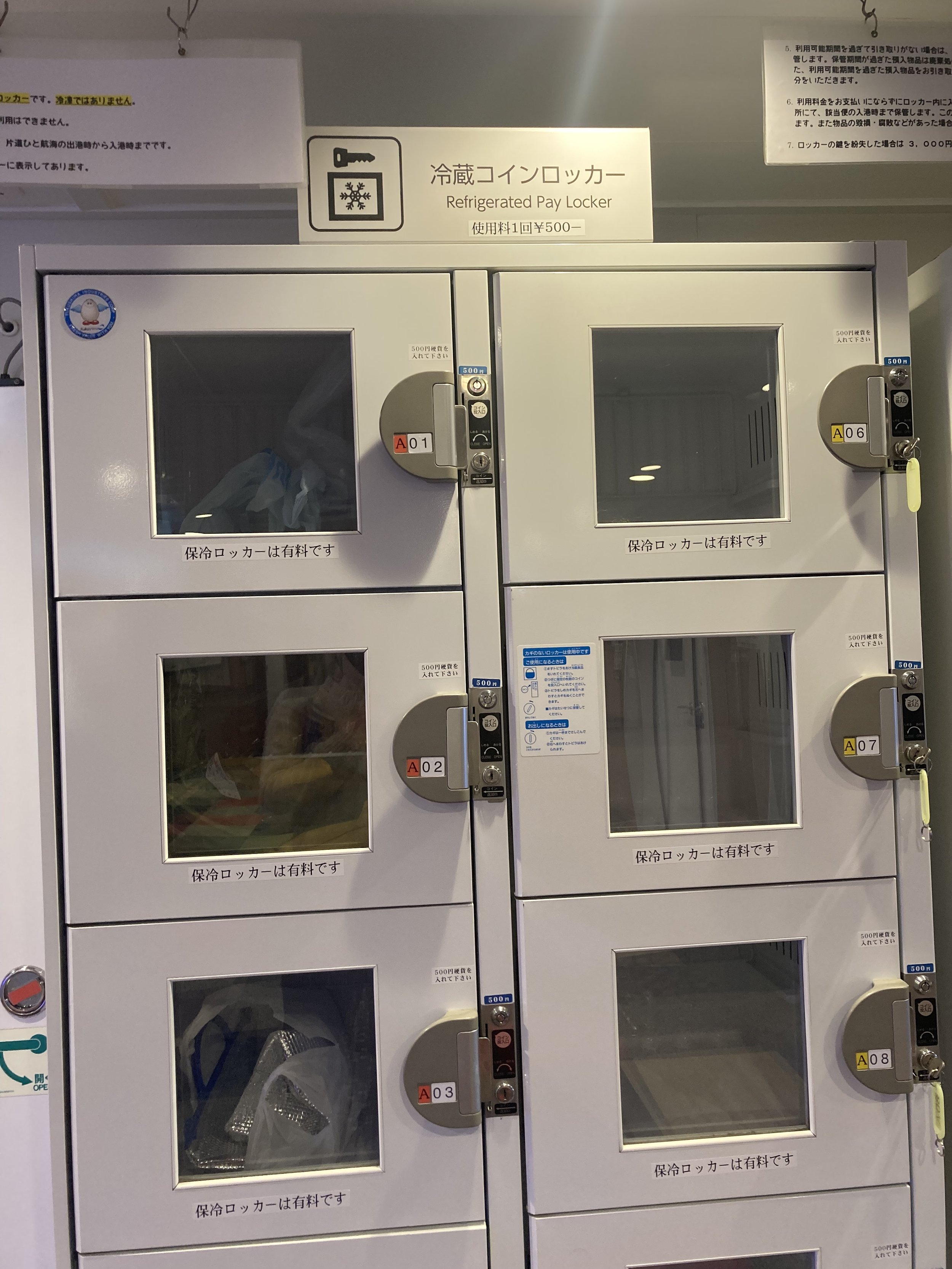Pacific Odyssey
Hello friends and family! Things are warming up in Tokyo, and we’re seeing flowers on the trees. It’s 2023 and the mask mandate finally lifted here a couple of weeks ago. As of today, though, most people are still wearing masks—outside, inside, while driving, and even when skiing alone. Updates on that someday in the future.
More importantly: In February we went on a wild adventure in the Pacific Ocean that I want to tell you about. Destination: Chichijima(父島)or “father” island. If you Google it, you’ll find a lonely dot way out in the water, almost as far south as Okinawa but technically still in Tokyo. It is part of the Ogasawara Islands (also known as the “Bonin” Islands). Iwo Jima is the closest recognizable landmark, but is still significantly further south.
It’s a place of stunning beaches and mountains, nearly zero light pollution, and (at one time, anyway) 95 species of snail. The big twist is that there are no airports in the Bonin Islands, and the only way to get there is on a ferry—a trip that takes 24 hours each way.
My husband stalked the ferry tickets for this trip for over a year, trying to buy before they sold out. I vaguely knew this plan was in the works, but (due to poor listening) didn’t fully understand the transportation situation until the vacation was upon us. At that point, I did think about the fact that both my son and I are prone to motion sickness. But the destination was cool and it’s not like you can’t bounce back from seasickness. So we went for it.
First, some background on Chichijima:
Chichijima is the largest and most populous island in the archipelago and is about 620 miles south of Japan’s main island. Its closest populated neighbor is called “Hahajima,”(mother island) and there is an unpopulated island next door that’s open to day tourists. “Bonin” means “no people,” and this is how the islands were first (creatively) described by those who found them.
The Bonin Islands were initially (and bizarrely) settled by several Americans, Europeans, and Hawaiian islanders in the 1830s. Ownership was retaken by the Japanese Meiji government in the 1870s. During the Second World War, the islands were mostly evacuated and residents were forced to move to the main island of Japan. After Japan surrendered, the U.S Navy controlled the islands for 23 years, only allowing descendants of the original western settlers and other white or Polynesian people to reside there. The Navy also destroyed the homes of former Japanese residents. In 1968 the U.S. returned the islands to Japanese control, and several hundred Japanese people resettled there. The islands’ collective population is now somewhere in the range of 2,100-2,500 people.
One more historic tidbit: in 1944, former U.S. president George H.W. Bush’s torpedo bomber was shot down near Chichijima. He was rescued by a U.S. submarine, but 8 other U.S. airmen were downed, executed, and some were then eaten by Japanese soldiers. Bush was the sole survivor, and was 20 years old at the time.
In short: the history here is dark and complicated.
Loading the ferry in Tokyo.
The Trip
During this part of the year, the ferry leaves Tokyo on Saturdays and returns on Thursdays. On our day of departure, our son woke up at 5am with a stomach bug. He had vomited 4 times by the time 8:30am rolled around. Against my own paranoid instincts, we sallied forth anyway, and at the ferry terminal he seemed better—running around and able to keep down a snack and some water.
We were 3 of maybe 6 white people getting on this ship (capacity 1,000). There were a few bubbly groups of young Japanese tourists in the ferry terminal, but everyone else looked pretty salty. Things got crowded in the terminal as departure approached, and we were relieved when boarding finally started.
The ship is called the Ogasawaramaru. It has 8 decks and was staffed by an unenthusiastic crew. The boat also had a bit of an odd scent—mustiness? Cow manure? I couldn’t be sure. But my husband sprang for one of the most expensive rooms on the ship, with its own bathroom, king sized bed, mini fridge, and semi-private deck. We got excited when we found it—clean and comfortable. We were going to enjoy this!
The Rainbow Bridge in Tokyo.
The ride out of Tokyo Bay was beautiful - we floated under the famous Rainbow Bridge and saw Mount Fuji from the water. We roamed around, drank some beers from the vending machine, snacked, and gazed at the shore passing by. Wow, this was fun!
Beer vending.
Then my son went down for a nap and we left the bay. The cruise experience transitioned from smooth sailing to turbulence, and he threw up about 3 minutes after waking up from his nap. Feeling the queasiness coming for me, I desperately went outside where I avoided vomiting for about 30 minutes before I, too, went down.
Many regrets about my choice to drink beer.
Luckily, every hallway had at least one barf bag station, so in my moments of post-vomit clarity, I got some bags, and went back to our room. Things were bleak in there—my son threw up again and my husband finally cracked about 20 minutes later. Then I suffered a second episode. It turns out watching and hearing other people vomit makes you more inclined to vomit.
The waves were huge and it felt like we were scaling and descending giant hills. We all lay down on the bed where we discovered that prone was the safest position. It was probably 2:30PM. We were only 3 hours into the trip. I realized that this might be a long and terrible ordeal.
The barf bags.
Using all of my keep-it-together skills, I executed a few small tasks like covering the bedsheet with puppy pads (why I had I brought those? An abundance of caution. Am I a hero? Aw shucks, don’t be silly). I also changed my son’s clothes—my husband had ninjaed the two vomiting incidents, and only a tiny bit had landed on my son’s shirt. But if you’ve ever had a spot of vomit hanging out near you, you know its malevolent power. Each task took three times longer than it should, and triggered frequent hesitation while clutching an open sick bag. Other basic things like picking up stuff on the floor, walking to the fridge to get water, or taking a shower were truly unthinkable.
Puppy pads: deployed.
We lay there together, rocking up and down, and I felt deep dread about the rest of the trip. My family drifted off to sleep. Eventually, it got dark. The waves seemed to get more violent.
I couldn’t read without getting sick. There was no cell service. Walking around was madness. There was no one to talk to. I realized that I was completely unable to accomplish anything. I wondered what would happen if the boat sank. Would adrenaline kick in, or would my brain consider the possibility of seasickness so intolerable that I wouldn’t be able to get up to save myself? The prospect of being in freezing water in the middle of actual nowhere trying to protect a 3 year old was so horrendous I kept thinking about it. A tourist boat sank off the coast of Hokkaido, Japan last year, after all. Then I wondered if, because I had nothing to distract me, I would have profound thoughts during this trip. How would I remember them without being able to write them down?
Then I felt liberated. I couldn’t remember a time like this—when there was nothing to do. I listened to the sounds of the ship: the front of the boat smashing into the water, possible liquid in pipes moving below the bed, a tiny creaking sound in the corners of our room, the (very) occasional sound of a door opening and slamming shut in the hallway, and the curtain string smacking the window. I looked at our sleeping son for a long time and realized I hadn’t watched him like that since he was a baby. I relaxed. At the top of a wave, it felt like I might lift off the bed and then the descent crushed me into the sheets. I felt like a baby myself, rocked in a huge crib operated by an emotionally unstable parent.
It was appalling to notice the vast space and contentment I felt. I’ve spent much time and effort trying to meditate, do yoga, focus on my breath, take a break from the pace of the day, etc. Maybe you have too? Well. Staring at the ceiling in our boat room, I realized that I’ve never successfully manufactured the feeling of being released from obligation. I now understood that in comparison to this, my efforts were pitiful. Sure, yoga and (attempted) meditation still helps. But have I ever been able to ignore the relentless onslaught of everyday tasks and responsibilities? No. I felt sad about this. Not just for me, but for anyone else who lives this way. It occurred to me that even things I enjoy—reading books, writing emails to friends, cooking—all contribute to a foundation of stress my days are built on. It seems like there is no real relaxation loophole that doesn’t result in undone tasks piling up to spite you later after you’ve “taken time for yourself.” I now know that the only way to truly escape the pressure is incapacitated by seasickness in the middle of the Pacific Ocean.
Should I write a self-help book?
Eventually I fell asleep. Anytime our son made a noise during the night, my husband and I would grab a sick bag in a panic and hold it out to him, but there were no further incidents. He woke up very early the next morning and said “Mama, I want lunch.” I fed him snacks on the bed while we all continued to exist horizontally. He was extremely game for lying down for 20 hours, and was enormously entertained by simple things like me walking my fingers around the bed and saying I was a spider. He drank a lot of water, and I almost cried when he finally peed for the first time, almost 24 hours after his last pee.
Towards the end of our trip, the ocean leveled enough that I could walk to the cafe and buy some unoffensive snacks (toast and pancakes). We sat up to eat, and feebly tried to get our stuff together. As we finally pulled into the bay at Chichijima, everyone’s spirits lifted and passengers flooded the decks. As a final reward for surviving, we saw two humpback whales off the side of the ship!
After docking, we made our way off the boat and found our ride. We were staying at the south end of the island where there are no stores or restaurants. The rental owner asked in several different ways, if we wanted to stop at the grocery store and repeatedly told us that there was nowhere to buy food near our lodging. We kept saying we didn’t need to go shopping, and he finally asked, “what will you eat?” We told him that my husband (the king of preparedness) had packed us a cooler filled with provisions to get us through the trip without having to wait in line behind all the other boat passengers at the store. The rental owner was impressed. He drove us along the beautiful coast to the south end of the island.
Kominato beach.
Kominato beach.
We stayed in a bungalow that was part of a group of houses surrounding a public bathroom building—it felt like summer camp. We put our stuff down and walked the 15 minutes to Kominato Beach, one of the most beautiful beaches on the island (according to the travel lit). The walk was along a well-maintained wide stone path that bordered a river. The trees in the roadside park were pruned, the paint on the parking lot pavement was crisp, the asphalt smooth. We looked, but couldn’t find any trash. A picnic table under construction was surrounded by cones with a laminated sign explaining the project and its completion date.
Our last island getaway was St. John in the U.S. Virgin Islands, and while were were struck by the beautiful scenery, it was impossible to miss the trash, disrepair, and poverty on display. No such situation here. Already miss you, Japan.
The walk to the beach.
The walk to the beach.
The Kominato Beach bus stop (A.K.A the southern-most bus stop in Tokyo).
The beach was completely empty—salt-and-pepper-colored sand, shallow blue water. The rock landscape around the beach had weird, natural designs that looked volcanic. We also noticed a discreet gun mount carved into one of the rock walls—in case you forgot those bloodier times.
It was about 70 degrees and breezy, which was warm enough to play and get our feet wet. My son had an especially good time. Over dinner we talked about how we still felt like we were on a ship, and not in a good way. Turns out it’s possible to feel seasick on solid ground.
The rocks at the beach.
And this.
The next day we rode the only cross-island bus into town. We found a seaside park with a playground, and then walked around looking for lunch. The local attitude towards us was generally…chilly. We are used to shop owners saying “welcome!” anytime we (or anyone) walk into a store in Tokyo, and unflinching courtesy in every life situation. This is not so much a white-people thing (which was more true in China) but a cultural norm regardless of skin-tone in Tokyo. On the island, shop attendants didn’t even look up when we walked in, usually staring at their phones. We entered through the wrong door at a restaurant and no one even turned their eyes our way until we left and reentered correctly. A mom and her toddler came over to play with us on the beach, and the mom said nothing at all to us until I asked how old the kid was. She answered the question, asked us where we were from, and then showed no interest in speaking to us again, despite sitting 3 feet away from me while our children played together for about 20 minutes. An endearing exception to this attitude was a group of young kids playing near our lodging with their mom/teacher/chaperone(?) As we walked by, they shouted “Hello!” in unison, and asked in Japanese if we’d gone swimming.
The only picture I took of the town itself.
We noticed that the locals expected us to speak Japanese and did not make much effort to help if we didn’t understand something. This was a refreshing challenge, but still a challenge. It was hard not to think about the history of the island and how it informs these interactions.
Near the playground, we found a plaque next to an empty flagpole saying that this was the site of a former elementary school founded by an American.
Flagpole of the former Admiral Radford Elementary school.
The shark burger.
We ate lunch at a place called “Heart Rock Cafe,” which sells a shark burger (we ate it, it was delicious). Fun side fact: when I googled “restaurants near me” I got results in Australia, Indonesia, Taiwan and Okinawa. Haha.
Then we took the bus home, and spent the afternoon at the beach again.
Our second full day on the island dawned…poorly for me. I was in gastric distress, probably felled by the same virus my son had. I crawled around the house between stints of lying in the fetal position (and other stuff). In the afternoon, in an attempt to make something at all of the day, my husband went for a hike.
Eventually, my son and I made our way slowly to the one cafe in walking distance to meet my husband after his hike. It was an airstream trailer with a charming deck built up to it, chickens wandering around. I was expecting more than just cookies and coffee, given it was the only food/bev oasis for miles, but expectations were not met. The woman working the shop switched to native-sounding English when I walked up to order. My son ate 5 cookies (!) and I sipped an apple juice. It was a wild afternoon.
Here are some pictures from my husband’s hike:
Kominato beach from above.
Beware.
On the last day, our son woke up at 6am and stood at the open window loudly singing “Mary had a little lamb” in Japanese while I tried to get him to be quiet. I told him our neighbors were still sleeping and he pointed at the window of the cottage next door and said loudly, “no, that lady is awake and eating an orange!” Haha! Many apologies, neighbors.
We spent the morning looking for snails. This was a slow process because we found a new snail every couple of feet. My son took a picture of each snail with my phone.
A Chichijima snail.
Then we took the bus into town again. He sat in the back and shouted out landmarks as we passed them. When we rounded the turn into the bay he yelled “there’s the Ogasawaramaru!” (the name of the ferry). This got some laughs from the other passengers. We wandered around town and spent some time at the playground. We sampled multiple frozen desserts, and I found a food truck selling hot and delicious french fries. My stomach was still cowering, but I was hungry and didn’t care. If we were going to barf our way home, why not enjoy some french fries beforehand? I bought some souvenirs, and we played on a stunning white beach coated in coral fragments (I got a sunburn).
Matcha ice dessert—the size of a human head.
The playground.
The coral beach.
Finally, it was time to board the ferry again. We were in the same room we’d had on the trip to the island, and this time I staged everything as soon as we boarded. Come at me, ocean!
As the ship got underway, all the passengers went to the decks, waving and yelling goodbye. People on shore waved back, and two drummers played us out. A handful of small boats followed us out of the bay—a local tradition—with people onboard screaming goodbye and some of them jumping into the water after us.
The sendoff brigade.
The glow from this warm and friendly send off was quickly obliterated by rough seas. The ocean conditions were much worse this time. The ship was shuddering for a most of the ride, and the heights and depths we were seesawing through were dramatic. We knew that horizontal was the only way to manage, so we all lay down in bed. My son fell asleep at 3:30pm and slept until 11pm. He woke up, ate a snack, and went back to sleep until the morning. Clearly he’d figured this out.
The snacks on board.
The hallway on deck 7.
That night, I expected and enjoyed the time I spent completely cut off from the world. I thought about the trip. Sure, I had barely seen any of the island, and had lost all my bodily fluids many times over. But I had scoured the ground for snails, and stared at a pristine beach for several hours. I’d watched our son run around and around the crest of a small hill, hugely entertained by the contours of the ground itself. ‘Twas a myopic approach, but I was somehow satisfied.
Also, I didn’t mention this before out of sheer embarrassment, but we DID have prescription-grade motion sickness meds with us that I had not taken on the trip out (I can’t really explain myself). On the trip home, my husband and I both took the meds and eventually, when I dared to get up from the bed, I understood their powers.
In the morning, I used my sea legs to explore the boat. I went down into “economy class” and checked out the sleeping situation there. A whole different world, friends. An economy ticket gets you a rollout futon in a big open room with other people sleeping side by side. There are little rooms for your luggage, for changing your clothes, and shelves for shoes. Public bathrooms. I kept imagining the horror of mass seasickness in these rooms.
One way to travel. The tilt of this photo is an accurate depiction of how I felt on the boat.
The middle class option (for lack of the accurate description) offers a bit more privacy, with individual bunks that come with curtains.
The more private mid-range bunks.
There is rentable freezer space and safes to store your cold goods and valuables.
Rentable cold storage - sorry for angle. The photographer was seasick.
At one point during our last 7 hours of boat time, our room suddenly became unbearably hot. I went to the Info desk to ask about the heat and they told me to turn off the thermostat completely. I also asked about some things we thought we’d left in the room on the trip to the island. One staff member stood up and walked away. I waited. It was unclear if she was responding to my question or just leaving—her colleague made no effort to explain. She came back a couple of minutes later and silently handed me the missing items. Haha! Thank you, ma’am! Pretty weird that they hadn’t just left the items in the room, or made any effort to tell us that they had our stuff. They knew we’d be on the return trip, right? The whole interaction felt just like the customer service in ye olde USA!!
Our room at the end of our long journey home.
We entered Tokyo Bay, and the final 2-3 hours of our trip home were smooth and stomach-friendly. We stood outside watching the cargo containers and cranes go by, and getting ready to reenter the real world.
Somehow, I have no regrets at all. In fact, I have been savoring the memory of my time as an isolated human speck rolling on the high seas. Everyone, I hope you, too, find yourself in a moment like that.
More someday. Thanks for bearing with this very long post.
Also, thanks to my husband for many of the photos in this post.



